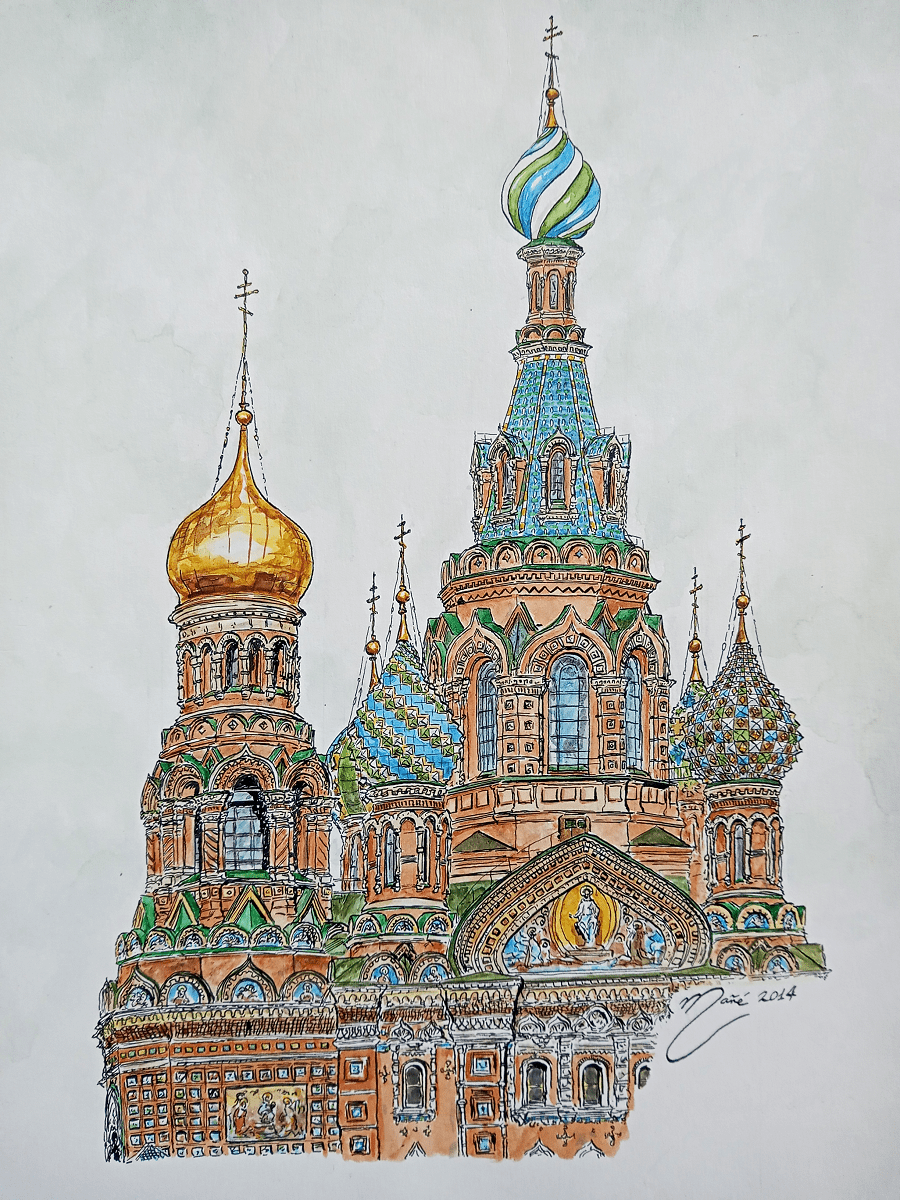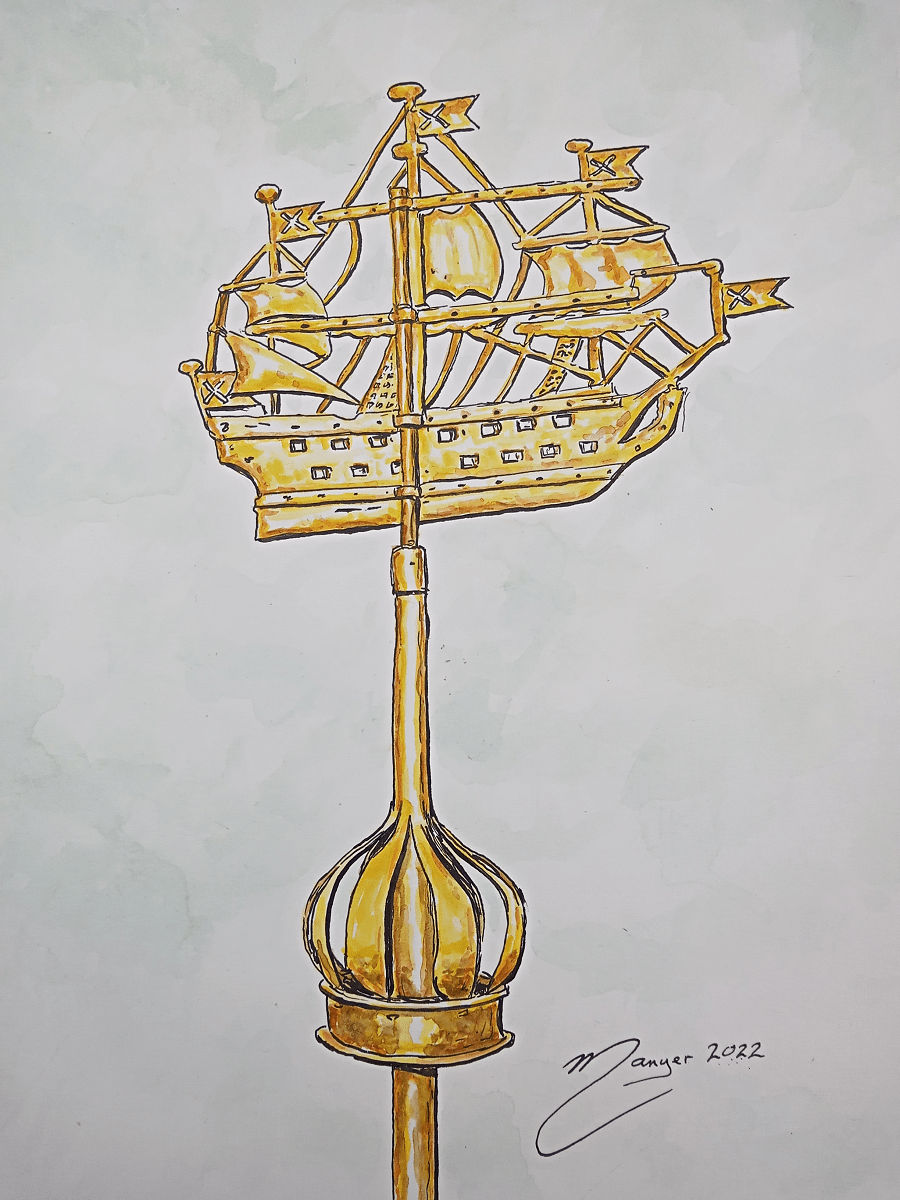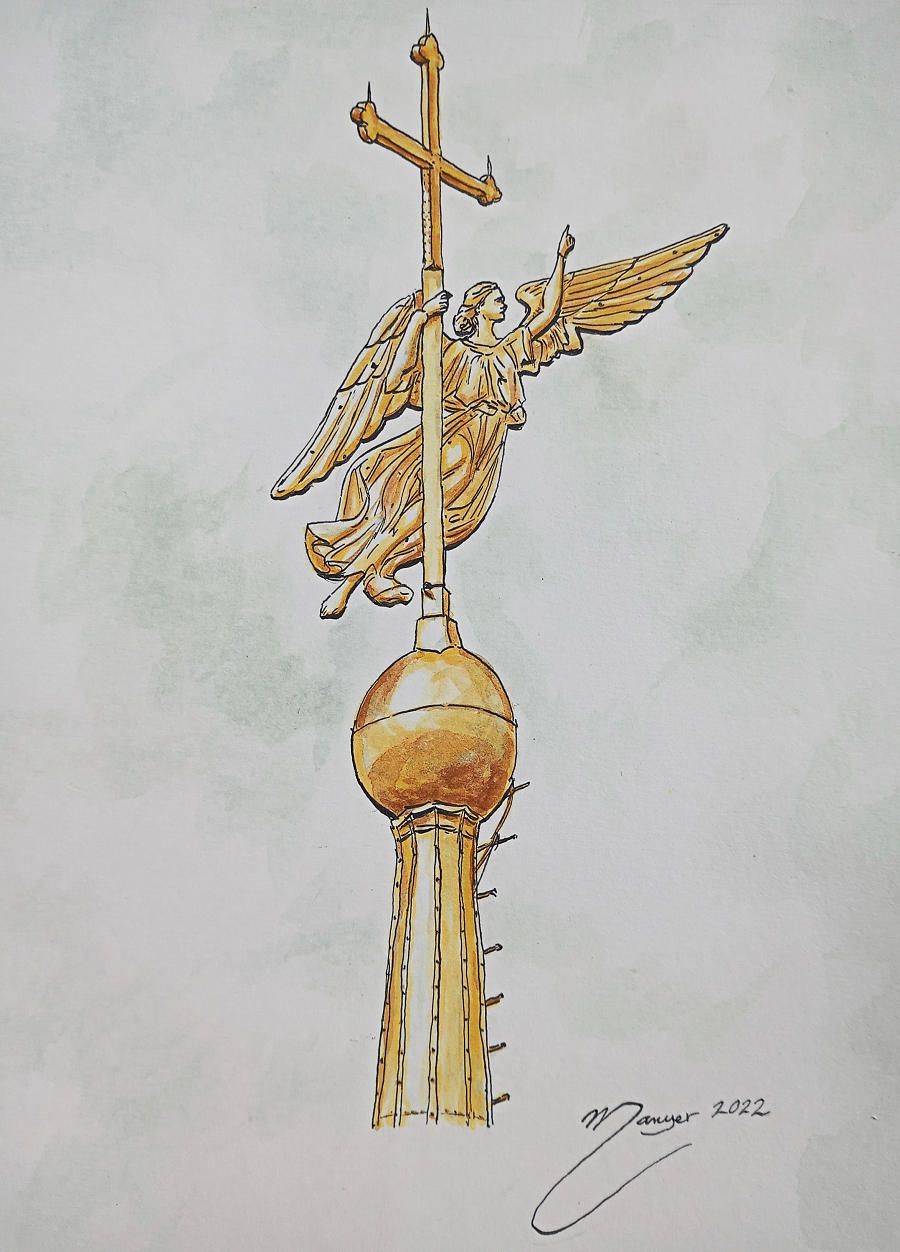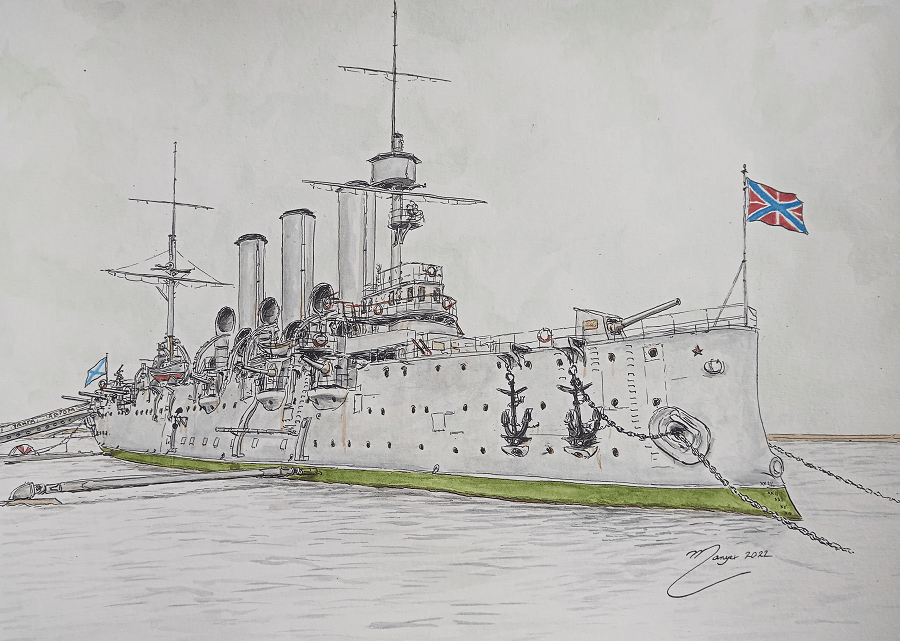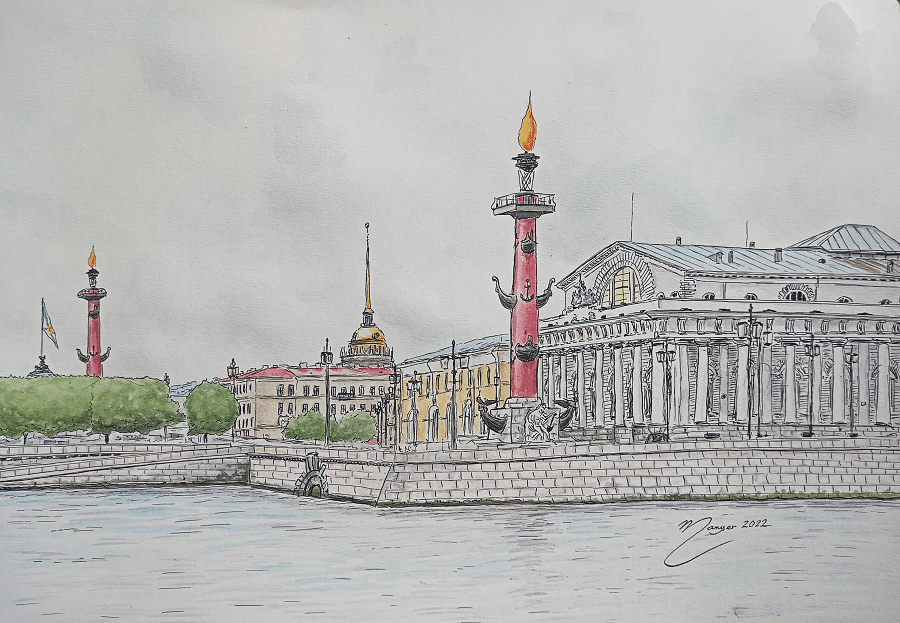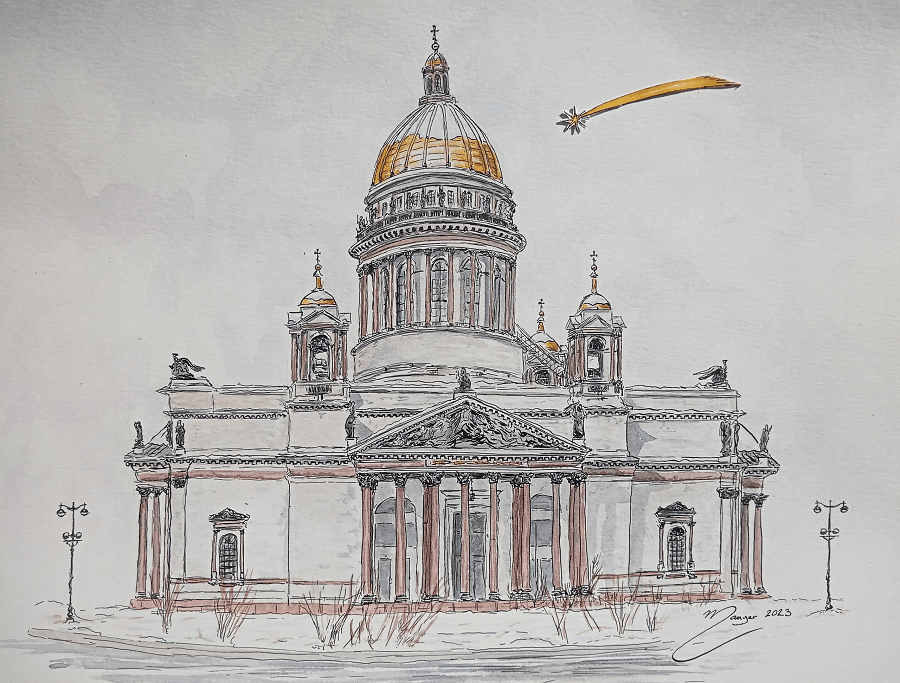Drawings by Joan Mañe
Saint Petersburg (from August 1914 to January 1924) – Petrograd, from January 26, 1924, to September 6, 1991 – Leningrad, colloquial – Peter, Petersburg, abbr. – St. Petersburg) is the second most populated city in Russia after Moscow. It is a city of federal significance and the administrative centre of the North-western Federal District. Tsar Peter founded it on May 16, 1703. Between 1714 and 1728 and 1732 and 1918, it was the capital of the Russian state.
It was named in honour of St. Peter, the heavenly patron of the founding king, but over time it became increasingly associated with the name of Peter I. The city is historically and culturally associated with the birth of the Russian Empire and the entry of Russia into modern history as a European great power.
It is in the northwest of the country on the coast of the Gulf of Finland and at the mouth of the Neva River. It borders the Leningrad region and has maritime borders with Finland and Estonia.
In St. Petersburg, there is the Constitutional Court of the Russian Federation, the Heraldic Council under the President of the Russian Federation, the embassy of the North-western Federal District, the authorities of the Leningrad Region, the Interparliamentary Assembly of the CIS, the main command of the Russian Navy and the headquarters of the western military district of the RF Armed Forces.
It was the centre of three revolutions: 1905-1907, February and October. During the Great Patriotic War in 1941-1944, it was under blockade for 872 days and caused the deaths of about a million people. On May 1, 1945, Leningrad was declared a Hero City. As of 2018, the federal city of St. Petersburg also includes three cities of military glory: Kronstadt, Kolpino and Lomonosov.
Population: 5,601,911 people. St. Petersburg is the northernmost city in the world with a population of over a million people. Also, St. Petersburg is the westernmost city with a population of one million in Russia. Among the European cities, it is the third largest city in terms of population (after Moscow and London), as well as the first largest non-capital city in terms of population.
The innovative scenario “Strategy for the development of St. Petersburg until 2030” assumes that by 2030 the population will be 5.9 million people. The city is the centre of the St. Petersburg urban agglomeration. The area of the city is 1439 km², after the expansion of the territory of Moscow on July 1, 2012, St. Petersburg is the second largest city in the country.
St. Petersburg is an important economic, scientific and cultural centre of Russia and a major transport hub. The historic centre of the city and the associated monument complexes are included in the list of UNESCO Sites and the city is one of the most important tourism centres in the country. Among the most significant cultural and tourist sites are the Hermitage, the Kunstkamera, the Mariinsky Theatre, the National Library of Russia, the Russian Museum, the Peter and Paul Fortress, St. Isaac’s Cathedral and Nevsky Prospekt. The program for the preservation and development of the historical centre of St. Petersburg also aims at preserving cultural heritage sites.
Main tourism facts
In 2016, St. Petersburg became the best destination for tourism in Europe according to the World Travel Awards.
In 2017, in the ranking of the most visited cities in the world by foreigners, St. Petersburg rose from 76th to 73rd place.
In 2018, St. Petersburg ranked second in the world in terms of the number of favorable hotel reviews on Booking.com. The average rental time for a room is 4.2 nights with a cost of 2.8 thousand rubles per day for 2-3 people.
In 2019, the American television channel CNN Travel recognized Nevsky Prospekt as one of the most beautiful streets in the world for its abundance of historical sites that were in good condition.
As of 2019, St. Petersburg ranked second in popularity of medical tourism after Tel Aviv.
Architecture and main attractions
In 1990, the historical center of St. Petersburg and the palace and park ensembles of the suburbs were included in the list of UNESCO World Heritage Sites. About 8,000 architectural monuments are under state protection.
In 2005, the St. Petersburg Strategy for the Preservation of Cultural Heritage was adopted. Architectural ensembles, strict straight streets, spacious squares, gardens and parks, rivers and numerous canals, embankments, bridges, patterned fences, and monumental and decorative sculptures determinethe majestic appearance of the city.
Among the buildings of St. Petersburg, representatives of up to 15 architectural styles can be counted. The main styles are considered baroque (two main varieties: “Petrine baroque”, characteristic of the beginning of the 18th century, and in the middle of the same century: “Elizabeth baroque”), classicism (late 18th century), empire (early 19th century), eclecticism (middle and close of the 19th century), modern (beginning of the 20th century) and constructivism (20th century).
Architectural ensembles of the 18th to 20th centuries: the Peter and Paul Fortress, the Alexander Nevsky Lavra, the Smolny Convent, Palace Square with the Winter Palace, the Admiralty, Nevsky Prospekt, the Spit of Vasilievsky Island with the Exchange building, Senate Square with a monument to Peter I, Architect Rossi Street and Ostrovsky Square, St. Isaac’s Square and, formed in the 20th century, Vosstaniya Square.
The rapid development of St. Petersburg has become a challenge to the traditional idea of a city with a long history, which grows and develops slowly. Peter I conceived the city on the model of Venice and Amsterdam: instead of streets paved with stone, the city was to be covered with a network of canals along which residents would move on light ships. Although Peter’s dream was not destined to come true, it was a foreign experience that formed the basis for further development.
The author of the first master plan of the city in 1716 was the Italian architect Domenico Trezzini: straight perpendicular streets and wide “avenues” became a characteristic feature of the new capital. Such a layout is visible in the example of Vasilievsky Island and the “trident”: Admiralty – Nevsky Prospekt, Gorokhovaya Street, Voznesensky Prospekt. Almost all the buildings in the central part of the city appeared later, but geometrically defined squares and streets have determined the appearance of the city until today.
The personality of Peter I played a decisive role in choosing the site of Nevsky Prospekt, the Admiralty, and the Peter and Paul Fortress, and introduced strict urban planning discipline. All buildings, according to his decree, were to be built of stone (at the same time, in all other cities of Russia, it was forbidden to use stone as the main building material).
In those days, the Petrine Baroque style became widespread and was represented by the Italians D. Trezzini, J. M. Fontana, N. Michetti, the Frenchman Jean-Baptiste Leblon, the Germans A. Schluter, G. Mattarnovi, and the Russian M. Zemtsov. The city has preserved several buildings built in this style: the Peter and Paul Fortress with the Peter and Paul Cathedral, the Kunstkamera, the building of the Twelve Colleges, and the Menshikov Palace.
In the middle of the 18th century, the Elizabethan Baroque style, represented by the architects F. B. Rastrelli (Winter Palace, Smolny Monastery, Great Palace in Peterhof, Great Catherine Palace in Tsarskoye Selo) and S. I. Chevakinsky (St. Nicholas Naval Cathedral).
In 1844, Emperor Nicholas I issued a decree prohibiting the construction of civil buildings in the city above the eaves of the Winter Palace. Since the second half of the 18th century, classicism has become predominant in the architecture of the city. The main architects of this style are V. I. Bazhenov (Saint Michael’s Castle), J.B. Vallin-Delamotte (the building of the Academy of Arts, the Great Gostiny Dvor), A. Rinaldi (Marble Palace), I. E. Starov (Tauride Palace, Trinity Cathedral of the Alexander Nevsky Lavra), G. Quarenghi (building of the Smolny Institute), C. Cameron (Pavlovsk Palace); and later (from the beginning of the 19th century) its variety, the Russian Empire style: A. N. Voronikhin (Kazan Cathedral), A. D. Zakharov (Main Admiralty), J. Thomas de Thomon (Spit of Vasilievsky Island), K. I Rossi (Mikhailovsky Palace, the building of the General Staff, the Alexandrinsky Theater, the building of the Senate and the Synod), V. P. Stasov (The Transfiguration Cathedral, the Trinity-Izmailovsky Cathedral), and O. Montferrand (St. Isaac’s Cathedral).
Eclecticism began to prevail in architecture in the middle of the 19th century: A. I. Stackenshneider (Mariinsky Palace, the Beloselsky-Belozersky Palace), A. P. Bryullov (Lutheran Church of Saints Peter and Paul), K. A. Ton (the building of the Moscow Railway Station), and A. A. Parland (Church of the Savior on Blood).
From the middle of the century, the construction of new embankments and bridges began, and a large construction of tenement houses was going on Liteyny, Vladimirsky and Zagorodny avenues were formedduring this period.
At the beginning of the 20th century, buildings in the Art Nouveau style appeared in the city, including the house of the Singer company, the Eliseevsky store, the Astoria hotel and the Vitebsk railway station. During this period, the decoration of tenement houses, private mansions and public buildings with stained-glass windows became widespread. Next came the neoclassical style (“House with towers” on Lev Tolstoy Square), which constructivism (A. Stachek Avenue, Kalinin Square, the station of the first stage of the Leningrad Metro)replaced in the 1920s.
In 1923, housing construction began in new areas on the principle of integrated development (“Zhilmassivy”).
From the beginning of the 1960s, the mass construction of “Khrushchev” began, and from the 1970s, “house-ships.” At the same time, buildings erected according to individual projects appeared: the Yubileyny Sports Palace, the Victory Square Ensemble, the Pribaltiyskaya Hotel, the sports and concert complex named after V. I. Lenin, and the building of the Pulkovo airport.
Recently, buildings in the historical center have been demolished: the barracks of the Preobrazhensky Regiment (one of the oldest in Russia) and the engineer battalion (Kirochnaya Street), five houses on Nevsky Prospekt, an 18th-century building and the interiors of the Chicherin House, several houses on Vosstaniya Street and Liteyny Prospekt, a house on Voznesensky Prospekt, some buildings on the Petrograd side and more. Some of the demolished houses had the official status of architectural monuments. In 2008, changes in legislation came into force, which lifted the ban on the privatization of monuments of federal significance, which had been in force in Russia since 2002.
Cultural heritage
Saint-Petersburg is a cultural center of world importance and is often called the “Cultural Capital” of Russia. The city has 8464 objects of cultural heritage, including 4213 objects of the cultural heritage of federal significance, which is almost 10% of all monuments protected by the state on the territory of the Russian Federation.
There are more than 200 museums and their branches (including the Hermitage (about three million works of art and monuments of world culture), the Russian Museum (the largest museum of Russian art), the Central Naval Museum, the Museum of the Academy of Arts of Russia, Kunstkamera, Roerich Family Museum-Institute, palace and park museums-reserves of Peterhof, Oranienbaum, Tsarskoye Selo, Pavlovsk); exhibition complex “Lenexpo”; more than 70 theaters (including the Mariinsky Theatre, the Alexandrinsky Theatre, the Mikhailovsky Theatre, the Bolshoi Drama Theater named after G. A. Tovstonogov, the St. Petersburg Academic Comedy Theater named after N. P. Akimov, the Maly Drama Theater (Theater of Europe), the St. Petersburg Academic Lensovet Theatre, the Baltic House, the Academic Drama Theater named after V. F. Komissarzhevskaya, the clown theater Litsedei, the Great St. Petersburg State Circus and many others); 1,100 libraries (the largest among them are the Russian National Library (Public), the Library of the Russian Academy of Sciences, the B. N. Yeltsin Presidential Library); more than 50 cultural and leisure institutions; and more than 50 cinemas.
Symbols
According to Article 7 of the Charter of St. Petersburg, the historical symbols of the city are the ship on the spire of the Admiralty, the monument “The Bronze Horseman”, and an angel on the spire of the Peter and Paul Cathedral. According to Article 8 of the Charter of St. Petersburg, the tradition is the midday cannon shot of a signal gun from the Naryshkin bastion of the Peter and Paul Fortress.
Full travel guide (320 objects)




